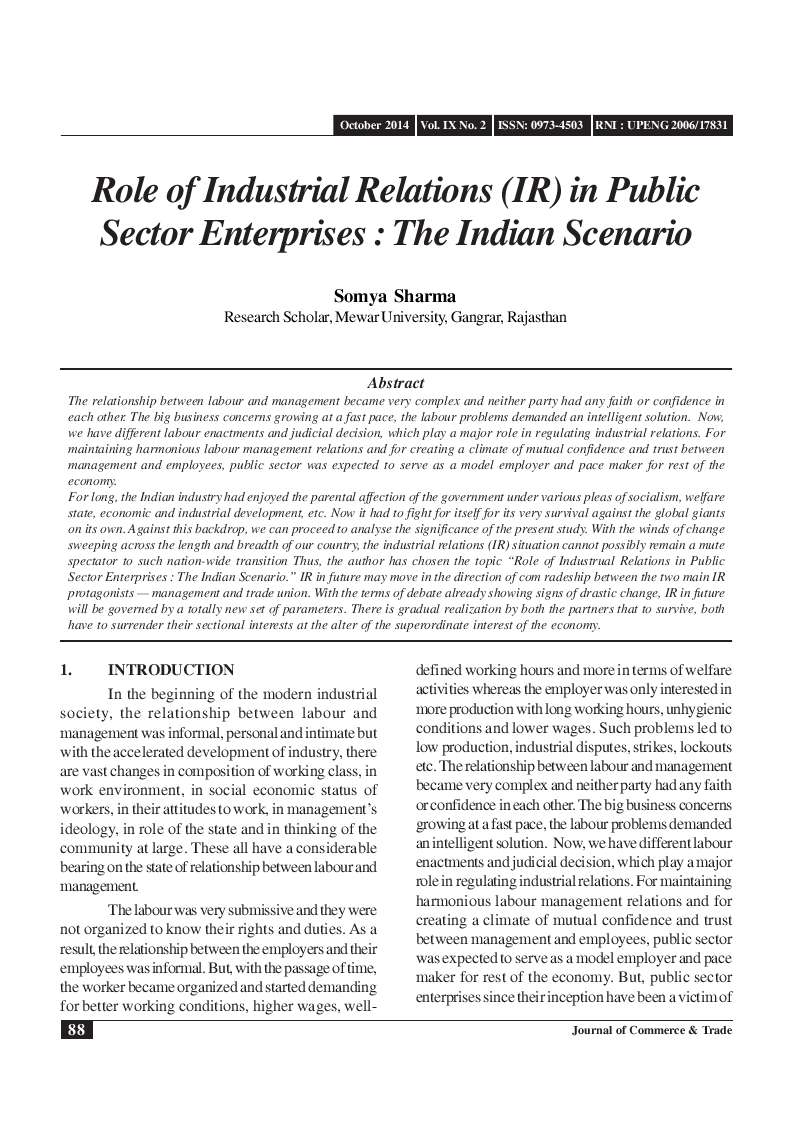Role of Industrial Relations in Public Sector Enterprises-The Indian Scenario
DOI:
https://doi.org/10.26703/jct.v9i2.265Keywords:
Industrial Relations, Public Sector Enterprises, IndiaAbstract
The relationship between labour and management became very complex and neither party had any faith or confidence in each other. The big business concerns growing at a fast pace, the labour problems demanded an intelligent solution. Now, we have different labour enactments and judicial decision, which play a major role in regulating industrial relations. For maintaining harmonious labour management relations and for creating a climate of mutual confidence and trust between management and employees, public sector was expected to serve as a model employer and pace maker for rest of the economy. Now, it had to fight for itself for its very survival against the global giants on its own. Against this backdrop, we can proceed to analyse the significance of the present study. With the winds of change sweeping across the length and breadth of our country, the industrial relations (IR) situation cannot possibly remain a mute spectator to such nation-wide transition. IR in future may move in the direction of com radeship between the two main IR protagonists — management and trade union. With the terms of debate already showing signs of drastic change, IR in future will be governed by a totally new set of parameters. There is gradual realization by both the partners that to survive, both have to surrender their sectional interests at the alter of the superordinate interest of the economy.
Downloads
Metrics
References
Chaudhuri, S (1995). Economic Times, Bombay, 13th September.
Sheth, N R (1993).’ ‘Labour Relations in the New Economic Environment,”Vikalpa, Vol 18, No 3, July - September.
L.L. Bethel, F.J. Atwater, G.H.E.Smith, and H.H. Stackman, “Industrial Organization and Management McGrand Hill 1945”.
J.H. Richardson, “An Introduction Study of Industrial Relations” Allen & Unurin, London, 1954 p. 442..
The Labour Management Committee of the Asian Regional Conference of the ILO.
Pramod Verma, “Management of Industrial Relations”. Oxford &IBH Publishing Co.New Delhi 1986. P.63
S.D. Punekar, S.B.Deodhar , Sankaran, Saraswathi Himalaya Publishing House, Bombay 1980, P.269.
Myers Charles and Subbiah, Kannappan “Industrial Relations in India”, Asia Publishing House, 1970, p.341
Economic Survey 2008-09
Govt. of India Report of the National Commission on Labor, 1969, p.362.
J.S. Mathur, “Indian working class Movement”, P.341
Alexander R.Herson : “Reasonable Goals in Industrial Relations” , Standard University Press, Stanford, California.
Global Management Conference – Bali, Indonesia April-May 2010
Davar, R.S., : “Personnel Management and Industrial Relations” Vikas, 1981, New Delhi
Michael, V.P., : “Industrial Relations in India and Workers Involvement in Management”. Himalaya Publishing House, 1979, Bombay.
Om Prakash : “The Theory and working of State Corporations”, Orient Longman Ltd. 1971, London.
Annual Reports of selected public undertakings.
Indian Journal of Commerce.
The Economic Times ( Leading News Paper of India) Several issues.
Indian Journal of Labour Economics.

Additional Files
Published
How to Cite
Issue
Section
License
Copyright (c) 2014 Journal of Commerce and Trade

This work is licensed under a Creative Commons Attribution 4.0 International License.







